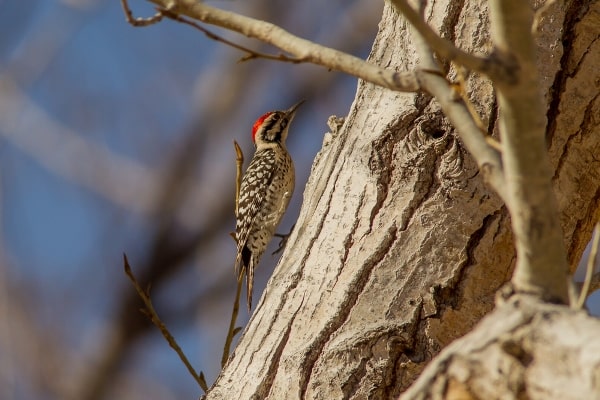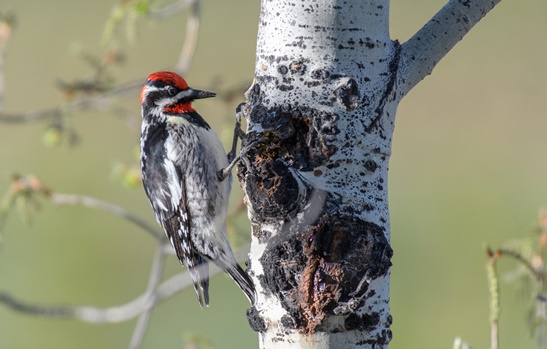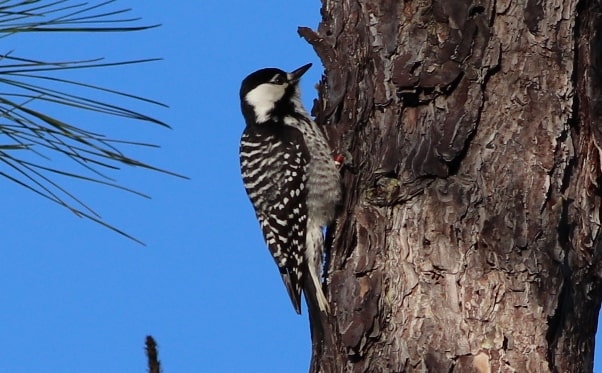Texas is a big state with a huge range of environments. Not only does that mean it has plenty to explore, but it also means that birdwatchers have the chance to spot a large number of different species. In fact, if you keep an eye out, you might spot 14 different types of woodpeckers in Texas.
Not all woodpeckers make Texas their home year-round, and a few species only stop by the state on rare occasions. But all of the following birds have been sighted in the Lone Star State.
Whether you live in the panhandle, are staying in an AirBnB in Houston, or make a highrise in Dallas your home, you have the opportunity to see many different woodpeckers if you know where to look and what to look for.
Here are the species you might see in Texas:
- Acorn Woodpecker
- Golden-Fronted Woodpecker
- Downy Woodpecker
- Hairy Woodpecker
- Ladder-Backed Woodpecker
- Lewis’s Woodpecker
- Northern Flicker
- Red-Bellied Sapsucker
- Red-Headed Woodpecker
- Red-Naped Sapsucker
- Red-Cockaded Woodpecker
- Williamson’s Sapsucker
- Yellow-Bellied Sapsucker
- Pileated Woodpecker
14 Types of Woodpeckers in Texas
1. Acorn Woodpecker

Scientific name: Melanerpes formicivorus
Size: 7.5-9 inches
Weight: 2.3-3.2 ounces
Wingspan: 14-17 inches
Acorn woodpeckers are sometimes described as having the face of a clown because they have a black mouth surrounded by a white border and black over their eyes. These clowns of the forest have a red cap, a black body, and a white patch on the rear and on each wing. The chest is light gray or white.
These woodpeckers live in evergreen forests on the west coast and a few parts of the southwest, such as Texas. They collect lots of acorns and use them to fill holes in trees full of the nuts they’ve collected. One tree may contain up to 50,000 holes, and the stored nuts can feed multiple generations of woodpeckers in Texas!
You might think that by the name, they only eat acorns, but they also eat insects, especially ants, seeds, nuts, and sometimes the eggs of other birds.
This is one of the few woodpecker species that prefers to live in small colonies rather than alone, and studies reveal that they do this to help one another raise young, a practice called cooperative breeding.
2. Golden-fronted Woodpecker

Scientific name: Melanerpes aurifrons
Size: 8.7-10.2 inches
Weight: 2.6-3.5 ounces
Wingspan: 16.5-17.3 inches
This woodpecker is quite distinctive, with a bold yellow nape and a bright yellow spot on the lower part of the abdomen.
Males also have a striking red crown and a patch of gold on the forehead. Both sexes have a faint yellow hue overall, which makes them almost appear as if they’re glowing from within. Their main body is pale gray and the wings are barred black and white.
These birds live in brush lands, tropical forests, and wooded habitats, but you might occasionally spot them in suburban yards and parks, especially if there’s suet available to them, so put out your feeders.
You might hear these birds before you see them. They have a loud call and they are quite vocal in the morning, especially during the spring. They also aren’t afraid of humans, so if they live in your area, they aren’t hard to spot.
These birds only live year-round in Oklahoma and Texas and south through Mexico.
3. Downy Woodpecker

Scientific name: Dryobates pubescens
Size: 7 inches long
Weight: 0.75-0.99 ounces
Wingspan: 10-12 inches
The downy woodpecker is the smallest woodpecker in Texas (and the rest of the US) and is extremely common across North America. It doesn’t migrate but instead chooses to stay in its home year-round, which means you might be able to spot it even during the winter.
You can find this itty-bitty woodpecker pretty much anywhere. It lives in rural areas, cities, suburban yards, and wilderness areas. It doesn’t mind the desert or a nice wooded area.
During the wintertime, they flock with other common birds such as chickadees and nuthatches. They build their nests in the cavity of trees where they live and raise their young. While they may change their habitat range during the seasons, they don’t travel too far. They like to stick around to the places they know.
Downy woodpeckers are black and white, with distinctly spotted wings and a white chest. Adult males have a bright red cap on the back of their heads, which makes them easy to identify from females.
If you want to watch these birds (and many other woodpeckers) in the wild, place a suet feeder in your yard. They love them and will come to hang out for a bit so that you can observe their antics.
Because of their small size, they can access parts of the tree or land on small stems of plants to hunt for food. They’re also small enough that they often make nests in the wood siding of homes, much to the dismay of homeowners.
4. Hairy Woodpecker

Scientific name: Picoides villosus
Size: 7.5 inches
Weight: 1.4-3.4 ounces
Wingspan: 13-16 inches
Hairy woodpeckers are sometimes confused with downy woodpeckers, but you can tell them apart because hairy woodpeckers are bigger and have a longer bill. Their bill is almost the same length as their head. They are black and white all over their bodies. You can tell the genders apart because the adult males have a little red spot on the back of their heads.
These pretty woodpeckers aren’t as common in cities as their cousin, the downy woodpecker. However, you can still see these woodpeckers in parks, suburban areas, cemeteries, and other quiet wooded or open areas in Texas. They also visit suet feeders in suburban backyards.
Like their cousin, the downy woodpecker, hairy woodpeckers don’t migrate during the cold weather and stay put all year, instead. They make their nests in the cavities of dead trees. Research published in The Journal of Wildlife Management found that they prefer forests that have been burned recently.
Populations have been declining in the past few decades because they’re losing their habitat. They also face pressure from invasive birds like European starlings, which steal their nesting spots.
5. Ladder-Backed Woodpecker

Scientific name: Dryobates scalaris
Size: 6.3-7.1 inches
Weight: 0.7-1.7 ounces
Wingspan: 13 inches
Across the arid deserts of the southwestern US live the Ladder-backed woodpecker. These tiny foragers flit among the cacti to find food, and they’ll also visit feeders to snack on mealworms or black oil sunflower seeds.
If you live in Texas, put out mealworms and sunflower seeds, and you have a good chance of spotting these lovely woodpeckers when they come to feed on these treats.
They’re black and white with white bars across the wings and back that look very much like a ladder. The chest is spotted black and white. The males have a red crown.
While other woodpecker species that make their home in the desert need large plants to make a nest in, these petite little birds can live in the scrub and shrubs. They’re a close relative of the Nutall’s woodpecker, but they have differing ranges.
6. Lewis’s Woodpecker

Scientific name: Melanerpes lewis
Size: 10.2-11 inches
Weight: 3.1-4.9 ounces
Wingspan: 19-.20.5 inches
This medium-sized woodpecker typically lives across the western half of the US, including Texas. They migrate from the northern part of the country to the southern region during the winter. When they’re breeding and migrating in the spring, you might spot them in the midwest or west. They don’t live in Texas, but they do occasionally stop by the western part of the state.
They don’t dig or peck into trees as most other woodpeckers do. Instead, they hunt for insects crawling around on the bark. Pairs mate for life and make nests in excavated trees or utility poles.
These pretty woodpeckers stand out with their green and pink feathers and red face with white necks. They also like to catch insects mid-air while they’re flying, which is a fairly unique behavior for a woodpecker.
As fall comes around, this industrious bird collects acorns and other nuts and stuffs them into cavities in trees so that they have food for later.
7. Northern Flicker

Scientific name: Colaptes auratus
Size: 11-12 inches
Weight: 4-6.5 ounces
Wingspan: 16.5-20 inches
The distinctive northern flicker woodpecker lives in open habitats near trees, as well as in parks and cemeteries across Texas. They are a frequent visitor to suet feeders in suburban and urban yards. Unlike some woodpeckers, they like to hunt around on the ground rather than in the trees.
The males, females, and juveniles vary in appearance. They’re brown in color overall, with black spots. The underside of the wings and tails are yellow in the eastern half of the US and red in the western half of the US.
Some have a red or black stripe on their cheeks, and many of them have large, black crescents on their chest. Others have red marks on the back of the head. Some have a slightly gray head.
In the spring, the calls of Northern flickers can be heard for a long way. It’s a common sound, and once you know how to identify their calls and drumming, it’s easy to tell when they’re around.
They primarily eat ants, but they’ll also dine on insects such as caterpillars, beetles, and termites. There are also instances of them catching young bats as they leave the nest. You can tempt them to visit your home by offering a suet feeder in the yard.
Flickers who live in Alaska and Canada will migrate to areas that have higher temperatures, like Texas, during the winter.
Studies show that Northern Flickers can lose their nests to invaders like European starlings.
8. Red-bellied Woodpecker

Scientific name: Melanerpes carolinus
Size: 9.5 inches
Weight: 2.0-3.2 ounces
Wingspan: 13.0-16.5 inches
You’d probably expect these woodpeckers to have bright red bellies, but that’s not the case. Usually, their bellies are a pale creamy white. Their back and wing feathers are black and white striped, and the females have a red nape. The males have a red nape and crown.
So where did the name “red-bellied” come from, then? The woodpeckers do actually have red feathers on their bellies, but they are usually covered by white feathers so you can’t actually see them.
These active birds live all across the Eastern United States, and you can spot them in the air as they fly by their undulating flight pattern. They live in the eastern half of Texas and may pop over to the western half from time to time.
Look for them in oak and hickory trees, where they like to feed and nest. They’ll also visit suet feeders now and then.
9. Red-headed Woodpecker

Scientific name: Melanerpes erythrocephalus
Size: 7.5-9.1 inches
Weight: 2.0-3.2 ounces
Wingspan: 16.5 inches
Red-headed woodpeckers are very striking. They have solid black wings with a big white patch, and white bodies. To top it off, a deep, dark red head and neck that is so vibrant it looks like velvet.
The juveniles are brownish-black with white spots on the wings and dull red cheeks.
They don’t cross the Rocky Mountains, but they can be found in all parts east, from Canada to Florida. They winter in Texas and northern Mexico, and breed in the northern end of the US and southern Canada.
It’s one of the few woodpeckers out there who like to store food for the winter. They stuff seeds and nuts in bark or holes in trees. They have even been known to stuff food under shingles.
They also hunt their prey, snatching insects out of the air. That’s uncommon behavior for woodpeckers and makes for an interesting show if you can catch it.
10. Red-naped Sapsucker

Scientific name: Sphyrapicus nuchalis
Size: 7.5-8.3
Weight: 1.1-2.3 ounces
Wingspan: 16-16.9 inches
As the name suggests, this bird eats the sap in trees. It will tap little holes into the bark so that sugary sap runs out and it can lick it up. They particularly love aspen, pine, and birch trees. They’ll even nest in backyards that have those trees, and they will stop and visit if you provide them with a suet feeder.
These sapsuckers have vertical white patches that you can only see when the wing is folded. They have black and white striped bodies and heads and a bright red cap and throat, though some females have a white throat.
This is a close relative of the red-bellied sapsucker and the yellow-bellied sapsucker. They all look fairly similar.
These woodpeckers only live in the northern part of Texas. They travel there during the non-breeding season and then fly north to breed.
11. Red-cockaded Woodpecker

Scientific name: Dryobates borealis
Size: 7.9-9.1 inches
Weight: 1.5-1.8 ounces
Wingspan: 14.2 inches
This non-migratory species lives year round in its habitat, which includes the southern states of the US from Virginia down the coast to Florida and as far west as the eastern edge of Texas.
You might expect this bird to have a dramatic red mark, given its name. In actuality, only the males have any red at all, and it’s a tiny little stripe on its cheek. Don’t try to identify this bird by the little streak, however. It’s pretty much impossible to see unless you’re right up close.
The rest of the bird is black and white with barred stripes on the wings and a mottled pattern on the chest. The head is white with a black crown and stripe down the cheek that extends down the neck. The males and females look similar.
This bird has been losing its habitat due to logging and suburban spread and is on the conservation red watch list and has been endangered since 1970. It lives in old-growth, long-leaf pine forests, so it’s unlikely that you’ll see this in your backyard.
If you go out hunting to spot this bird, be aware that many of its habitats are protected and closed to public access. Bird watchers may, however, be able to obtain permission to search for them.
12. Williamson’s Sapsucker

Scientific name: Sphyrapicus thyroideus
Size: 8.3-9.8 inches
Weight: 1.6-1.9 ounces
Wingspan: 17 inches
Like other sapsuckers, this one drills small holes into trees. Then they wait for the sap to start leaking out and they drink it. They also eat ants and other small insects.
These woodpeckers prefer coniferous forests, and they live in the mountains of western North America, including Texas year-round. They spend their time in the higher elevation forests and drop down to lower elevations during the winter. However, in the 1990s, scientists found that this sapsucker had extended its range as far south as Baja California.
Large for a sapsucker, the males are mostly black with white patches on the wings and a red throat. The females have horizontal barring on their backs. They also have brown heads. The sexes appear so different from one another that scientists originally thought that they were different species.
The males carve out holes in trees to create a nest for the female to lay her eggs in.
13. Yellow-bellied Sapsucker

Scientific name: Sphyrapicus varius
Size: 7.1-8.7 inches
Weight: 1.5-1.9 ounces
Wingspan: 13.4-15.8 inches
The beautiful yellow-bellied sapsucker lives in the eastern half of the US but it will rarely head over to warmer parts of the western US like Texas during the winter.
These birds are mostly black and white, with white bellies, and black and white barred wings and back. You can tell the difference between males and females because the throat of the male is bright red. Females, on the other hand, have a white throat. Both the females and males have red foreheads.
The females have a faint yellow coloring to their bellies, but it can be so indistinct that you might not be able to identify it.
The birds drill little holes with their beaks and then they wait for the sweet sap to emerge from the tree. They lick this up, as well as any insects that crawl along and get themselves stuck in the sap.
You might see them hanging out at your backyard suet feeder, but they mostly stick to forested areas.
14. Pileated Woodpecker

Scientific name: Dryocopus pileatus
Size: 16-19 inches
Weight: 9-14 ounces
Wingspan: 30 inches
The pileated woodpecker only lives in the eastern quarter of the state in forested areas. They often make their nests in utility poles or high up in tall trees in deadwood. Their favorite snack is carpenter ants, which they will dig rectangular holes deep into the wood to find.
They’ll also eat nuts and berries and have even been known to chomp on poison ivy berries. You may occasionally see them foraging on the ground for food, but they usually stick to the trees.
These striking birds are mostly black and white, but they are very distinct because of their bright red crest. The males also have a red stripe on the side of their faces. These are larger birds, about the same size as a crow.
The pileated woodpecker doesn’t migrate. It stays in the same area year after year. They will, however, move their nest if the eggs fall out of it.
The cartoon bird Woody Woodpecker was likely based on this species.
Also Read: Owls in Texas
